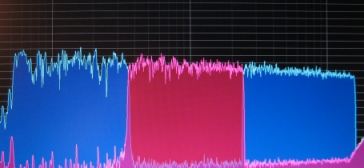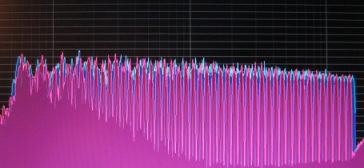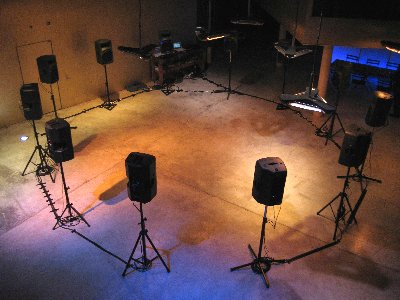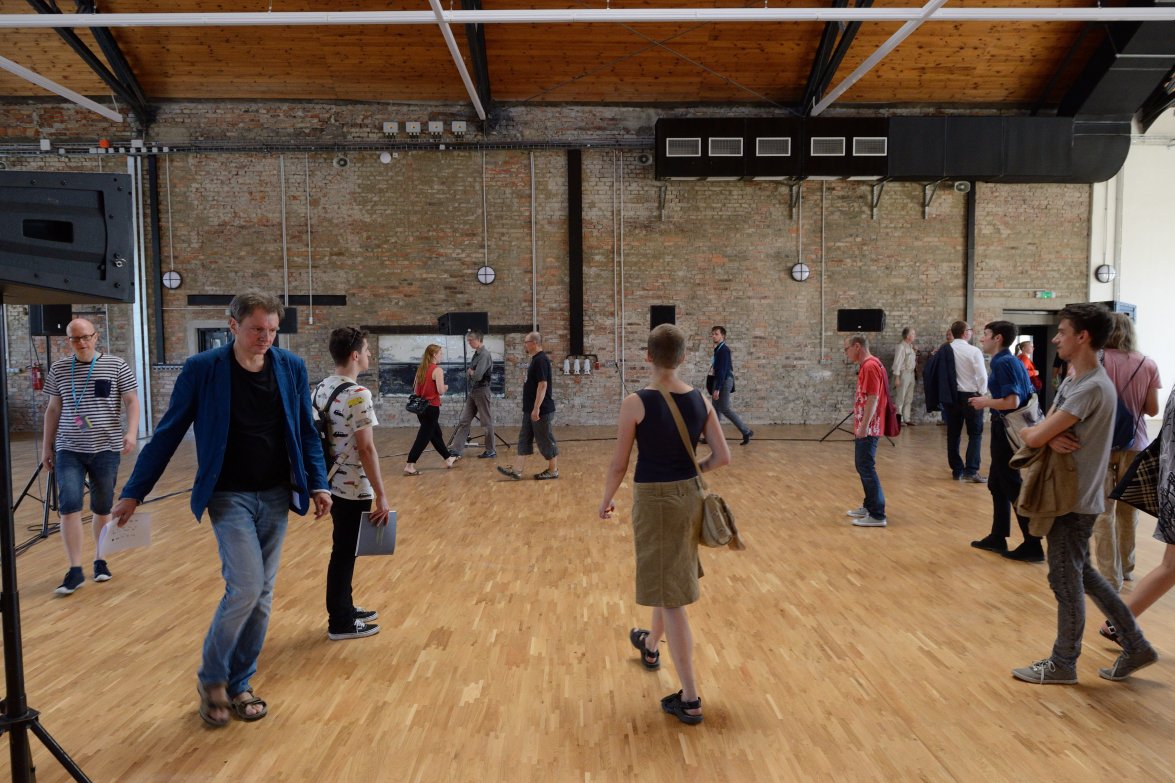Peter Ablinger:
WEISS / WEISSLICH 27
"komplementäres Rauschen",
Lautsprecher-Installationen und Stücke auf CD
- complementary noise
loudspeaker installations and pieces on CD
verschiedene Versionen:
27a ("Kreis"): 8 Lautsprecher, begehbar (1995)
27b ("Divisionen"): 2 Lautsprecher, Stühle (1995, Neufassung 2001), 12' > dt.Text
27c ("Parabol"): 7 Lautsprecher, begehbar (1998)
27d ("für Winfried Ritsch"): 12 Lautsprecher, begehbar (2001) > dt.Text



Weiss/weisslich 27b, the first 3 divisions of white noise in sonographic view; blue: left channel, red: right channel; and below the last of 18 divisions with semi-tone small bandwith. (Each division sounds for 40 seconds.)

Different versions of Weiss/weisslich 27 (installations and concert-pieces):
27a "circle": 8 loudspeakers, walk-in installation (1995)
27b "divisions": 2 loudspeakers, chairs, 12' (1995, reconstruction 2001) > engl.text
27c "parabola": 7 loudspeakers, walk-in installation (1998)
27d "for Winfried Ritsch": 12 loudspeakers, walk-in installation (2001) > engl.text
 |
 |
 |
 |
short video (59sec) from the Paris circle on > youtube
"...ob es nicht besser gelingen möchte, wenn er den Zuschauer sich drehen, und dagegen die Sterne in Ruhe ließ." Immanuel Kant, Vorrede zur zweiten Auflage der Kritik der reinen Vernunft
- "Rauschen" - white noise - is the totality of sounds.
At the same time the maximum and the minimum of information.
The maximum, as everything always.
The minimum, as infinite redundancy.
In all the pieces of Weiss/weisslich 27 - in correspondence to white light - the spectrum of white noise is refracted into partial spectrums. In a way the sum of these partial spectrums results furthermore in being "white" (everything). The difference between (distinguishable) partial spectrums and their (indistinguishable) sum is the subject of these pieces.
The piece for 12 loudspeakers divides White Noise into 12 equal parts. Each single loudspeaker is 1/12 of totality, sounding as if it were one single pitch of the chromatic scale. When walking in circles one can hear an endless ascending - or descending - scale. But in the center one hears plain white noise: the "Everything". (English notes edited by Andrew Smith) > Traduction franšaise

Weiss/weisslich 27d, circle of 12 loudspeakers, at Ostrava Days 2015. Credits: Martin Popelar, OCNM archive
-
Peter Ablingers akustische Täuschung
Im zweiten Stock der Hlubina-Coal-Mine-Gebäude in einem eigenen Raum sorgt ein rauschender Sog, eigentlich ein Sog des Rauschens für Verwunderung. Der österreichische Komponist Peter Ablinger hat eine seiner "weiss/weisslich"-Installationen aufgebaut. Zwölf im Kreis aufgestellte Lautsprecher rauschen in bestimmten Tonhöhen, so weit so gut. Aber es gibt zumindest zwei mirakulöse Erscheinungen zu hören. In der Mitte des Raumes heben sich die Tonhöhen gegenseitig auf, man findet sich in einem farblosen, fast weißen Rauschen wieder. Vor allem aber: Geht man die zwölf Lautsprecher im Kreis ab, scheint die Tonhöhe von Lautsprecher zu Lautsprecher kontinuierlich ab- oder anzusteigen, je nach Gehrichtung. Das Irritierende ist nur, selbst nach der dritten Runde ist das immer noch so. Was wirkt wie kontinuierlich ansteigend ist eine akustische Täuschung, eine akustische Treppe wie das berühmte endlose Treppenbild von M. C. Escher. (Christian Scheib über Weiss/weisslich 27d bei den Ostrava Days 2015
Weiss/weisslich 27b, first version produced at Experimentalstudio / SWR Freiburg; Reconstruction of Weiss/weisslich 27b and Weiss/weisslich 27d designed by Thomas Musil, produced at IEM Graz. Weiss/weisslich 27d, a circle of 12 loudspeakers, is installed in the 'Cube' of IEM Graz (Institute of Electronic Music, University Graz) and can be presented on request.
contact the publisher for performance material:
 ZEITVERTRIEB WIEN BERLIN
ZEITVERTRIEB WIEN BERLIN
Bryan Eubanks, Gotzkowskystr. 15, D-10555 Berlin,
T: +49 / 176 / 47 39 29 97, zeitvertrieb@proton.me
related pieces and documentations:
> Instruments and Noise, pieces for instruments and noise from CD
> IEAOV, Instruments and Electro-Acoustic Site-specific Verticalisation
> ALTAR, 2nd part of "Altar": complementary study
> Rauschen, documentation